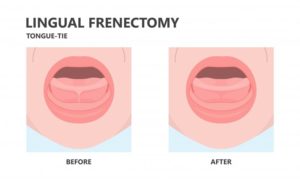
Breastfeeding is supposed to be easy—or so you thought. It’s been a struggle with your little one, and now they’re starting to try solid foods. Unfortunately, they don’t seem to handle certain textures very well. During a playgroup with other moms, you talk about your troubles with a friend, and they recommend talking to a pediatric dentist about possible tongue-tie treatment.
The tissue underneath their tongue does seem thick, but a procedure to fix it seems drastic on your little baby. Perhaps knowing what to expect will help you feel more confident about doing something about it!
Before Tongue-Tie Treatment
How do you know if tongue-tie treatment is even necessary? You may notice certain symptoms that could point to a tongue tie:
- Inability to latch or breastfeed properly
- Sore nipples from the baby biting down
- Failure to thrive or low weight gain
- Gagging or throwing up solid foods
- Difficulty with speech or speech impediments
Prior to resolving a tongue tie in a procedure called a frenectomy, your dentist needs to meet with you in a consultation. First, they examine the tongue tie to see how restrictive it is, and then they may ask you questions about struggles you may be experiencing as a result of the tongue tie. Having this appointment is necessary because it allows your dentist to understand your situation and put together a treatment plan to address the problem.
During Tongue-Tie Treatment
If your dentist has access to advanced technology, they may have a soft tissue laser, which makes the process much faster, more comfortable, and easier to heal afterward. Instead of using a scalpel, basically, the dentist pinpoints the laser on the excess tissue, severing and cauterizing it simultaneously. Laser frenectomies usually last only a few minutes and involve little to no pain. In fact, don’t be surprised if your dentist doesn’t use any local anesthetic at all!
After Tongue-Tie Treatment
Almost instantly following a laser frenectomy, you should see improvement. In fact, many dentists encourage nursing mothers to breastfeed immediately afterward, both to soothe the baby and also to allow them to enjoy better oral function right away.
Again, with laser technology, there should be very little bleeding or pain, so healing is expedited. However, you may receive some aftercare instructions from your dentist, depending on your situation. For those with speech impediments or occupational issues, therapy may need to be continued for a while afterward until proper function is achieved.
Having an idea of what to expect from treatment can help you gather the courage to move forward with it. Now that you understand how tongue-tie treatment works, you can go ahead and get it done so that you and your little one can have an easier time nursing and growing together.
About the Practice
At Dr. Glen’s Happy Teeth, we are privileged to have three doctors on our staff. Dr. Glen is our board-certified pediatric dentist, Dr. Anisha Gala is our orthodontist, and Dr. Benny Tong is our general dentist. We take advantage of cutting-edge technology like a soft tissue laser to perform advance procedures like laser frenectomies. If you think your child has a tongue tie that needs correction, you can schedule an appointment by calling our Long Beach office at 516-431-5855 or going to our Contact Us page here.


